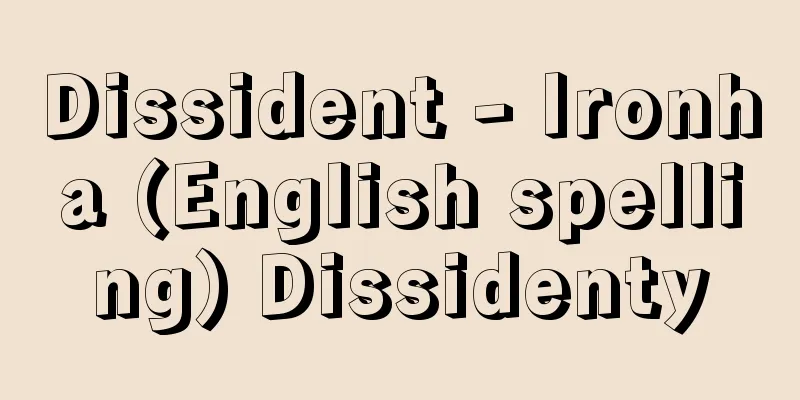Corneal transplantation

|
The cornea is a transparent tissue about 500 micrometers (1 micrometer is 1/1000 of a millimeter) thick that covers the iris of the eye. If the cornea, which acts as a window that lets light into the eye, becomes cloudy or distorted, it can impair vision. Currently, a method has been developed to treat corneal opacity using an excimer laser, but if the opacity is deep or the distortion is significant, the cornea must be replaced with a new one. Corneal transplantation is a surgery in which a diseased cornea is replaced with a healthy, transparent, undistorted cornea. An eye bank is an institution that secures the corneas needed for this surgery, checks their safety and quality, and provides them to corneal transplant doctors. [Kazuo Tsubota] HistoryCorneal transplants were first attempted in 1789 by G. Pellier de Quengsy (1750/51-1835). At the time, Catholicism was deeply rooted, and it was not possible to remove an eyeball from a human body, so a glass transplant was used, but it immediately fell off and failed. He then tried to transplant a rabbit's cornea onto a cat's cornea, and also conducted experiments with rabbit-to-rabbit corneal transplants. A mother also sacrificed herself for her child and attempted to transplant one eye, but the technology was immature at the time, so it was unsuccessful. In 1906, Eduard Konrad Zirm (1863-1944) succeeded in the first corneal transplant from a living donor, and from around 1922, Vladimir Petrovich Filatov (1875-1956) of the Soviet Union attempted to perform full-thickness transplants using cadaveric corneas, finally succeeding in 1928 as a groundbreaking discovery. This triggered the rapid development of corneal transplants, which became particularly popular in the United States, where eye banks were also established. At the time, Japan had the Law on the Dissection and Preservation of Corpses, which allowed organ removal from corpses for academic research, but any other purpose was punishable by the crime of desecrating a corpse. Ophthalmologists watched the excellent results of other countries for a while, but determined to catch up with Western technology, they continued to conduct research using animals. Then, in November 1949, Iwate Medical University Ophthalmology Professor Imaizumi Kitetsu (1907-2009) performed the first successful corneal transplant in Japan. In March 1956, an unofficial "eye bank" was established at Iwate Medical University. However, in October 1957, following media reports, Imaizumi was arrested for desecrating a corpse. Thanks to efforts from all quarters, the case was not prosecuted, but opinions grew stronger that it was unreasonable for medical procedures performed in good faith to circumvent the law, and the "Law on Corneal Transplants" was passed as a private member's bill in 1958. This law was made up of two parts: the first part stated that it was permissible to remove an eye for the purpose of a corneal transplant, and the second part contained provisions for eye brokerage businesses, or so-called eye banks. This marked the first official step in the introduction of corneal transplant treatment in Japan. With the spread of kidney transplants, this law was reorganized as the "Cornea and Kidney Transplant Law" in 1979. Later, in 1997, with the establishment of the "Organ Transplant Law," the "Cornea and Kidney Transplant Law" was abolished. Currently, corneal transplants are performed based on the Organ Transplant Law, and if the deceased person expressed their intention to donate their cornea for corneal transplantation in writing while alive and their surviving family members agree, corneas can be extracted from brain-dead people under this law. In addition, if the donor (cornea donor) is cardiac dead, even if they did not express their intention in writing while alive, corneas can be extracted with the written consent of their surviving family members. [Yasuji Kuwahara and Kazuo Tsubota] Preoperative testingIf eye tissues other than the cornea are damaged, vision cannot be expected to be restored, so a preoperative examination is necessary. (1) A slit-lamp examination is performed to check the state of corneal opacity, as well as the presence or absence of inflammation or adhesions, and the presence or absence of vascular invasion. (2) Measure intraocular pressure. If intraocular pressure is high, transplant surgery is not performed. Even if intraocular pressure is low, caution is required as there is a risk of ciliary atrophy. (3) A glaucoma stress test is used to determine whether the patient has a predisposition to developing glaucoma. Corneal transplant surgery can cause severe trauma and inflammation, which can sometimes lead to increased intraocular pressure. (4) Electroretinogram (ERG) is a test of retinal function using electrical responses, which is used to determine whether or not corneal transplant surgery is possible. [Yasuji Kuwahara and Kazuo Tsubota] Methods of corneal transplantationIn kidney transplants, a relative may donate one kidney to receive the transplant, but in corneal transplants, an allocornea (a cornea from another person) is generally transplanted from a donor. However, in recent years, with advances in regenerative medicine, autologous cells are sometimes used to transplant the corneal epithelium. This will be discussed later. In a typical corneal transplant, a central portion of the cornea, approximately 7.5 to 8.0 mm in diameter, is taken from the donor eye and transplanted into the recipient. The graft is sutured with a thin thread called 10-0 nylon. During this procedure, it is important to ensure that the donor cornea does not become distorted, causing astigmatism. In addition, a full-thickness corneal transplant is a procedure in which the entire cornea is replaced with a harvested cornea, but in recent years, a "part transplant" has become common, where only the damaged parts are transplanted. The cornea is broadly divided into epithelium, stroma, and endothelium. Transplantation of only the epithelium is called "corneal epithelial transplantation," transplantation of only the upper layer of the stroma from the epithelium is called "lamellar keratoplasty (LKP)," and transplantation leaving the corneal endothelium intact is called "deep lamellar keratoplasty (DLKP)." Deep lamellar corneal transplantation leaving the endothelium intact is now becoming the primary surgical procedure, as it can significantly reduce the risk of rejection. In addition, for corneal endothelial diseases, "descending endothelial keratoplasty (DSAEK)," in which only the corneal endothelium is transplanted, has been increasing in recent years. This has significantly reduced the risk of astigmatism, which is prone to occur after a full-thickness transplant. These techniques, which improve the postoperative condition by leaving even a portion of the patient's own cornea intact, have made corneal transplantation a higher-quality transplant medical treatment. After surgery, immunosuppressants such as cyclosporine A are not required, as in normal organ transplants. Inflammation is suppressed by steroid eye drops alone. In addition, while human leukocyte antigen (HLA) matching is required for kidney and liver transplants, this is not necessary for corneal transplants. [Kazuo Tsubota] Corneas suitable for transplantationThe lifespan of the cornea is said to be 200 years, so as long as the cornea is transparent and does not have any of the problems described below, people with myopia, astigmatism, or cataracts can become donors. In addition, with advances in science that have made it possible to perform endothelial cell testing, there are no longer any age restrictions. HLA matching is not required for the cornea, but the number of endothelial cells is important because endothelial cells do not divide, out of the three types of epithelial cells, endothelial cells, and endothelial cells. Many eye banks consider corneas suitable for transplantation to have a cell count of 2,000 or more per square millimeter as measured with a specular microscope. Donors who should not be used for corneal transplants due to illnesses include death of unknown cause, central nervous system disease of unknown cause, congenital rubella, hepatitis (HB, HC antigen positive), AIDS, Creutzfeldt-Jakob disease (a transmissible neurological disease), rabies, blastic leukemia, lymphosarcoma, and endogenous eye diseases (glaucoma, iritis, retinoblastoma, malignant tumors of the anterior segment of the eye). [Kazuo Tsubota] Corneal storageIn the United States, a corneal preservation solution called MK medium (hereafter referred to as MK) was developed in 1980, and corneal transplants have grown rapidly since then. MK is a preservation solution that allows preservation for one week by artificially providing conditions similar to those of aqueous humor (water inside the eye). Conventional whole eye preservation had a limit of 24 hours. However, when the extracted eyeball is made into a sclerocorneal fragment and stored in MK, it can be preserved for one week, which provides more time and eliminates the problem of checking for infection, and the utilization rate of corneas has increased dramatically. Whereas emergency surgery was necessary when preserving the whole eyeball, MK makes scheduled surgery possible, allowing doctors to be fully prepared. The Eye Bank Association of America (EBAA) was founded in 1961, but has grown rapidly since introducing this preservation method in 1980. Currently, preservation solutions that are superior to MK, such as Optisol and K-sol, which can preserve corneas for 10 days, are used, and there is a greater supply of corneas. In Japan, a method of preparing and preserving corneal slices using tissue culture medium was introduced in the 1990s. This method is very useful as it usually lasts for 7 to 10 days. However, only a few eye banks preserve corneal scleral slices, and many eye banks do not use this preservation method due to various reasons such as financial and human resources. [Kazuo Tsubota] Regenerative medicine and corneal transplantsSince Tsubota Kazuo et al. published a clinical report on corneal epithelial stem cell transplantation in 1999, regenerative medicine for the corneal epithelium has made rapid advances. The patient's remaining corneal epithelial stem cells are cultured to create an epithelial sheet, which is then transplanted. In cases where the patient does not have any remaining corneal epithelial stem cells, methods have been developed to harvest and create stem cells from a relative, or to culture and transplant cells from the patient's own oral mucosa. This has opened the way to treatment for eye disorders such as chemical trauma that were previously considered untreatable. Currently, research into the regeneration of the corneal stroma and endothelium is actively progressing. In addition, for severe corneal epithelial disorders such as Stevens-Johnson syndrome, tears have a significant impact on the healing rate after transplantation, so there are hopes for lacrimal gland regeneration technology. [Kazuo Tsubota] Current situation and future challengesThe medical standard of corneal transplantation has risen from the idea of simply maintaining the transparency of the cornea to the idea of how to eliminate astigmatism after surgery and provide practical vision without causing myopia or hyperopia. Furthermore, advances in deep lamellar corneal transplantation have made it possible to perform corneal transplantation without rejection. There are various methods to prevent astigmatism, but the most common method is to reduce astigmatism by using a single running suture, which is made by continuously suturing with 10-0 nylon thread and fine-tuning it during and after surgery. In addition, a method to correct refractive errors using an excimer laser has also been developed (approved by the Ministry of Health, Labor and Welfare on January 28, 2000), and is attracting attention as a new treatment method to improve vision after transplantation. At present, donor corneas are still necessary for corneal transplants. In Japan, it is estimated that 20,000 corneal transplant surgeries are needed annually, but only about 1,500 eyes are transplanted each year, and the number of cases in which corneas are imported from overseas for treatment is increasing. Although corneal transplants are well known in Japan and many people agree to undergo transplants, this is not reflected in medical care, and there is a need to improve the eye bank system. [Kazuo Tsubota] "Eye Banks: The Latest Advances in Corneal Transplants" by Kazuo Tsubota (1992, Nippon Hyoronsha)" ▽ "Challenges to Eye Banks" by Kazuo Tsubota (1997, Chuokoronsha)" ▽ "The Latest Science of Transplant Medicine: Emerging Possibilities and Limitations" by Kazuo Tsubota (2000, Kodansha Bluebacks)" ▽ "If It's Not the Best, It's Meaningless! - A Record of a Corneal Specialist Striving to Create the Best Eye Bank" by Kazuo Tsubota (2001, Haga Shoten) [References] | | | |Source: Shogakukan Encyclopedia Nipponica About Encyclopedia Nipponica Information | Legend |
|
角膜は、目の表面の黒目の部分をおおう厚さ約500マイクロメートル(1マイクロメートルは1ミリメートルの1000分の1)の透明な組織である。目のなかに光を通す窓の役目をしているこの角膜が混濁したり、ゆがんだりしてしまうと視力に支障をきたす。現在、角膜混濁に対してはエキシマレーザーを用いてこれを治療する方法も開発されているが、混濁が深い場合やゆがみが大きい場合には、これを新しい角膜と交換する必要がある。角膜移植は病気の角膜を透明でゆがみのない健康な角膜と置き換える手術である。この手術のために必要な角膜を確保し、安全性と質を確認して角膜移植医師へ提供する機関が眼球銀行(アイバンク)である。 [坪田一男] 沿革角膜移植は1789年にペリー・ド・クァンシーG. Pellier de Quengsy(1750/51―1835)が最初に試みた。当時はカトリックの勢力が根強く、人体より眼球を摘出することができなかったので、ガラスを使って移植したところ、ただちに脱落して失敗した。ついでウサギの角膜をネコの角膜へ移植したり、ウサギからウサギへの角膜移植実験が行われた。また母親がわが子のために自分は犠牲となって一眼を移植したが、その当時は技術的に未熟であったために成功しなかった。1906年になってツィルムEduard Konrad Zirm(1863―1944)が初めて生体の角膜移植に成功したが、1922年ごろからソ連のフィラトフВладимир Петрович Филатов/Vladimir Petrovich Filatov(1875―1956)が死体角膜を使用し全層移植を行うことを試み、ついに1928年に成功、画期的な発見となった。これを契機として角膜移植が急速に発展し、とくにアメリカで盛んに行われ、眼球銀行も発足した。 当時、日本では屍体(したい)解剖保存法があって、学術研究のために死体より臓器を摘出しても差し支えないが、そのほかの目的で行うと死体損壊罪により罰せられた。眼科学者は海外の優秀な成績をしばらく静観していたが、なんとか欧米の技術に追いつきたい一念から、動物を用いた研究を重ねた。そして1949年(昭和24)11月に、岩手医科大学眼科学教授今泉亀撤(きてつ)(1907―2009)が日本で第1例目となる角膜移植を行い、成功させた。1956年3月には非公式の「目の銀行」が岩手医科大学に発足された。ところが、1957年10月にマスコミ報道に端を発し、今泉は死体損壊罪で検挙された。各方面からの努力もあり不起訴となったが、善意をもって行う医療行為が法の網をくぐりながら行うのは不合理であるという意見が強くなり、議員立法として「角膜移植に関する法律」が1958年に成立した。 この法律は2部からなり、第1部は角膜移植のためであれば眼球を摘出しても差し支えないということと、第2部は眼球斡旋(あっせん)業、いわゆる眼球銀行の規定である。これは、日本における角膜移植医療の正式な第一歩となった。 なお、この法律は腎(じん)移植の普及とともに1979年「角膜及び腎臓の移植に関する法律」に再編された。その後、1997年(平成9)「臓器の移植に関する法律(臓器移植法)」の成立に伴い、「角膜及び腎臓の移植に関する法律」は廃止された。現在、角膜移植は臓器移植法に基づいて行われており、死亡した者が生存中に角膜移植のために角膜を提供する意思を書面により表示しており遺族が同意するときは、同法に基づき、脳死者からも角膜を摘出できるようになった。なお、ドナー(角膜提供者)が心臓死の場合は、生前の書面による意思表示がなくても、遺族の書面による同意があれば摘出できる。 [桑原安治・坪田一男] 術前検査角膜以外の目の組織が傷んでいると視力の回復は期待できないので、あらかじめ術前検査が必要である。 (1)細隙灯(さいげきとう)顕微鏡検査によって、角膜の混濁の状態をはじめ、炎症や癒着の有無、血管の侵入の有無などを調べる。 (2)眼圧測定を行い、眼圧が高ければ移植手術は行わない。眼圧が低い場合も、毛様体萎縮(いしゅく)のおそれがあるので注意を要する。 (3)緑内障負荷試験によって、緑内障になる素質のある目かどうかを調べる。角膜移植手術が大きな外傷性炎症となり、場合によって眼圧が上昇することがある。 (4)網膜電位図(ERG)は電気的反応による網膜機能の検査で、これによって角膜移植手術の可否を決める。 [桑原安治・坪田一男] 角膜移植の方法腎臓移植などでは血縁者から片方の腎臓を提供してもらい移植することも行われているが、角膜移植では基本的にドナーからのアロ角膜(他人の角膜)を移植する。ただし、近年、再生医療の進歩から、角膜の上皮に関しては、自己細胞による移植が行われることがある。これについては後述する。 一般的な角膜移植では、直径約7.5~8.0ミリメートルの角膜中央部分をドナー眼球から採取し、これをレシピエント(受容者)に移植する。移植片は10-0ナイロンとよばれる細い糸を用いて縫合する。この際、ドナー角膜がゆがんで乱視を発生しないようにすることが重要である。 また、採取した角膜にすべて入れ替えるものを「全層角膜移植」というが、近年では悪い部分のみを移植する「パーツ移植」が行われるようになってきた。角膜は大きく分けて、上皮、実質、内皮に分けられる。上皮のみの移植を「角膜上皮移植」、上皮から実質の上層部のみを移植する方法を「表層角膜移植(LKP)」、角膜内皮を残して移植する方法を「深層表層角膜移植(DLKP)」という。この内皮を残す深層表層角膜移植は、拒絶反応のリスクを大幅に低下させることができるため、現在では主要な術式となりつつある。また、角膜内皮の疾患には、角膜内皮のみ移植する「角膜内皮移植(DSAEK)」も近年増えている。これにより、全層移植後に起きやすい乱視のリスクが大きく低減された。患者本人の角膜を部分的にも残すことで術後の状態をよりよくするこれらの技術により、角膜移植は一段と質の高い移植医療となってきている。 術後は通常の臓器移植のようにシクロスポリン(サイクロスポリン)Aなどの免疫抑制剤は必要ない。ステロイド点眼だけで炎症を抑制する。なお、腎臓や肝臓などの移植の際には組織適合性抗原(HLA)を一致させる必要があるが、角膜移植においては必要ない。 [坪田一男] 移殖に適した角膜角膜の寿命は200年といわれているので、角膜が透明で以下に述べるような問題がなければ、近視や乱視、白内障でもドナーになれる。また、科学の進歩により内皮細胞検査が可能となったため、年齢制限もなくなった。 角膜はHLAの一致は必要ではないが、角膜の上皮細胞、実細胞、内皮細胞のうち内皮細胞は分裂しないため、内皮細胞の数が重要となる。スペキュラマイクロスコープで測定して1平方ミリメートル当り2000以上の細胞数を保持する角膜が移植に適した角膜と考えているアイバンクが多い。 角膜移植に使用してはならないドナーの病気としては、原因不明の死、原因不明の中枢神経系疾患、先天性風疹(ふうしん)、肝炎(HB、HC抗原陽性)、エイズ、クロイツフェルト・ヤコブ病(伝播(でんぱ)性の神経疾患)、狂犬病、芽球性白血病、リンパ肉腫(にくしゅ)、内因性眼疾患(緑内障・虹彩(こうさい)炎・網膜芽細胞腫・前眼部悪性腫瘍(しゅよう))などがあげられる。 [坪田一男] 角膜の保存アメリカでは、1980年にMKミーディウム(以下MK)という角膜保存液が開発され、角膜移植は急成長を遂げた。MKは、人工的に眼房水(目の中の水)と同じような条件を供給することによって1週間の保存を可能にする保存液である。従来の全眼球保存では24時間が限度であった。しかし摘出した眼球を強角膜片にしMKに保存すると1週間の保存が可能なため、時間的に余裕が生まれ、感染症のチェックの問題も解消し、角膜の使用率が一気に向上した。全眼球保存の場合は緊急手術が必要であったが、MKにより予定手術が可能となり、万全の体制で臨めるようになったのである。 アメリカのアイバンク・アソシエーション・オブ・アメリカ(EBAA)が発足したのは1961年であるが、この保存法を取り入れた1980年以降、急成長を遂げている。現在は、MKより優れたオプチゾールやK-ソルなど10日は保存できる保存液が使用され、より余裕をもった角膜の供給が行われている。 日本でも、1990年代に入って、組織培養液を用いて角膜切片を作成し、これを保存する方法が導入された。このような方法では、通常保存期間が7~10日になるためとても有用である。しかしながら、強角膜切片保存は一部のアイバンクが行っているだけで、資金・人材などさまざまな理由により、この保存法を用いていないアイバンクも多い。 [坪田一男] 再生医療と角膜移植1999年(平成11)に坪田一男らが発表した角膜上皮の幹細胞移植の臨床報告から、角膜上皮に関しては再生医療が急速に発展してきた。患者本人に残っている角膜上皮の幹細胞を培養して上皮シートを作成し移植する。本人の角膜上皮の幹細胞が残っていない場合は、親族の幹細胞を採取して作成したり、本人の口腔粘膜の細胞を培養したりして移植する方法も開発されている。これにより従来では治療不可能とされた化学外傷などの眼障害などに治療の道が開けた。現在は角膜実質や内皮の再生の研究が盛んに進められている。 また、スティーブンス-ジョンソン症候群などの重症な角膜上皮障害に関しては、涙が移植後の治癒率に大きく影響をする。よって涙腺の再生技術にも期待がされている。 [坪田一男] 現況と将来への課題角膜移植は、ただ単に角膜の透明性を維持するという考えから、術後いかに乱視をなくすか、近視遠視を引き起こさずに実用的な視力を与えられるか、というレベルまで医学水準が上がってきた。さらに深層表層角膜移植の進歩により拒絶反応のない角膜移植が可能となってきた。乱視を起こさないための方法にはさまざまなものがあるが、シングル・ランニング・スーチャーといって10-0ナイロン糸によって連続縫合を行い、手術中および術後にこれを微調整することによって乱視を減らす方法が一般化している。また、エキシマレーザーにより屈折異常を矯正する方法も開発され(2000年1月28日厚生省認可)、移植後の視力をより高める新たな治療方法として注目されている。 角膜移植のためには、今のところまだドナー角膜が必要である。日本においては、年間2万件の角膜移植手術が必要と推算されているが、年間の移植件数は1500眼ほどで、海外から角膜を輸入して治療するケースも増えている。 日本では角膜移植に対する認知度は高く、移植への同意も多いものの、医療に反映されておらず、アイバンクのシステムの整備が必要とされる現状である。 [坪田一男] 『坪田一男著『アイバンク ここまで進んだ角膜移植』(1992・日本評論社)』▽『坪田一男著『アイバンクへの挑戦』(1997・中央公論社)』▽『坪田一男著『移植医療の最新科学――見えてきた可能性と限界』(2000・講談社ブルーバックス)』▽『坪田一男著『ベストじゃなければ意味がない!――最高のアイバンクの実現に奮闘する角膜専門医の記録』(2001・芳賀書店)』 [参照項目] | | | |出典 小学館 日本大百科全書(ニッポニカ)日本大百科全書(ニッポニカ)について 情報 | 凡例 |
>>: Cornea - English spelling: cornea
Recommend
Hiyoshi Taisha Shrine
Located in Sakamoto, Otsu City, Shiga Prefecture. ...
Voiceprint - Seimon
It is a pattern created by analyzing the characte...
Lead sulfide - Ryukanamari (English spelling)
The chemical formula is PbS. It occurs naturally a...
Betting -
〘 noun 〙 The act of gambling. Also, the item that ...
Kanmon system
...Even in the samurai territories, the Tokuso te...
Treason - Muhon
[Noun] (Suru) 1. To rebel against the rulers of th...
Annales School
The Annales School (French: L'école des Annal...
Orontes Dynasty - Orontes Dynasty
…Uartu (Ararat in the Old Testament), closely rel...
Convention on the Elimination of All Forms of Discrimination against Women
(Common name for the "Convention on the Elimi...
Bude - Guillaume Budé
French humanist. Born in Paris. He studied law an...
Collegiya
…The Northern War lasted 21 years, and his domest...
Moroz
...The transition from winter to summer and back ...
MPN - MPN
《 multi-payment network 》⇒Multi-payment network So...
Kanetsu Tunnel
This expressway tunnel is located on the Kan'...
Nitten Exhibition
A comprehensive art organization. An abbreviation...





![Sumeru [Mountain] - Sumeru](/upload/images/67cbfa90695de.webp)



